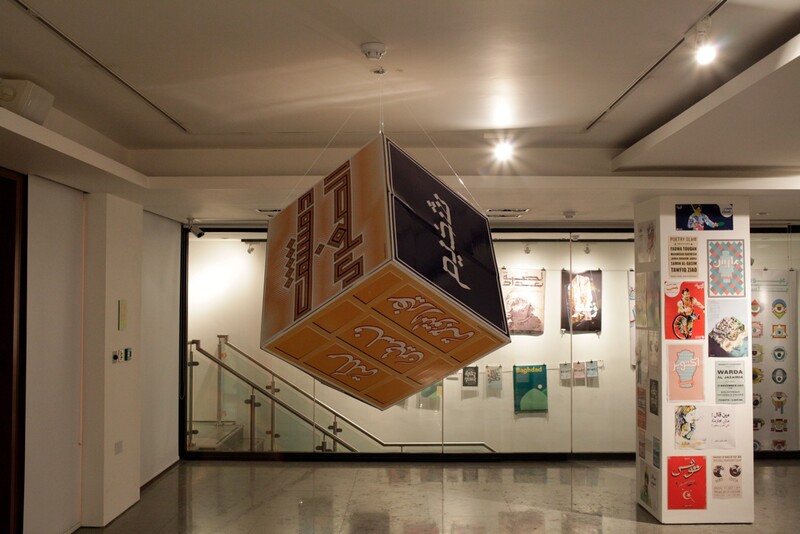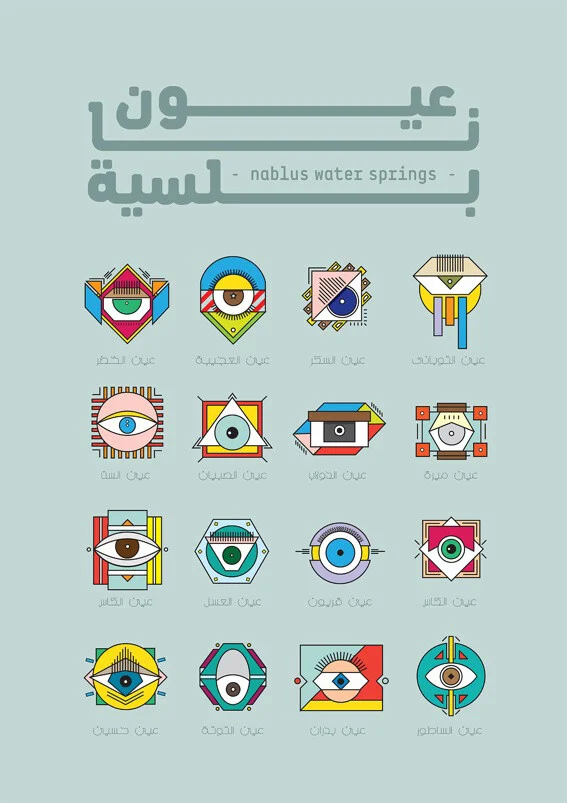The Electronic Intifada London 21 October 2013

Maajoun Studio’s cube suspended from a ceiling at the P21 gallery features epithets for Nablus on each of its sides.
Two main themes emerge from the London-based P21 Gallery’s new exhibition In the City, which showcases graphic design responses to the cities of Nablus, Algiers, Alexandria and Baghdad.
The first is how fine and blurred the line now is between graphic design and fine art. P21 displays works selected for their aesthetic quality, and yet In The City is very much designated as a “design” show, even when the featured works are of types and styles which could equally be found in an “art” show.
The second is the issue of how the Arab world is portrayed and described, especially by the West. In its introduction to a series of posters titled “National Day of the Whale,” the Cairo-based Nayzak Studio emphasizes the ahistorical image of “the East” that often dominates — an image drawn from a exoticized past, where unlike Greek or Norse myths, Arabic legends are not updated and retold, and where the stereotypes of Arabic and Middle Eastern culture are distant and strange, beautiful but savage.
In contrast, the works shown in In the City stress the interaction between cultures and between tradition and modernity. They assert that Middle Eastern and North African culture can be vibrantly modern on its own terms, not necessarily by absorbing Western art, and while still respecting and drawing on its own heritage.
So, for example, a poster for an imagined poetry slam in Nablus announces the venue as “Neapolis Theater,” a reference to the Roman-era theater built into the foot of one of the West Bank city’s famous mountains. The line-up is a veritable dream team of Palestinian poets, the present represented by Samih al-Qasim and the past — much more recent than that of the “venue” — by Mahmoud Darwish, Fadwa Touqan, Jabra Ibrahim Jabra and Tawfiq Ziad.
Meanwhile, Nayzak’s own images rework a myth, recounting how: “A whale visits the city shores every year. They only leave when the city folks serve food and play music for them, while ambergris extractors stay alert for the moment they will vomit.”
The mix of celebration and brute pragmatism gives the tale a sense of authenticity, while the posters designed by Nayzak are a pointed reminder of how states appropriate myth and memory in their construction and regulation of power and identity.
“Trembling surprise”

A poster in the ”National Day of the Whale” series by Cairo-based Nayzak Studio.
In the quieter space of the basement gallery, dominated by Ibraheem Youssef’s vast painting of the Martyrs’ Memorial in Algiers, Lebanese artist Nour Tabet again plays with the themes of past and present.”Paradoxes of Iskandariyya” displays a wall of “birthday party invitations” and the venue for this imaginary event is listed as “the collapsed building in Sidi Gaber…20:00 sharp for a trembling surprise.”
This device recalls both the crumbling mansions of Alexandria and the threat that faces this aspect of the city’s heritage, and the ways in which urban spaces — and by extension histories and memories — are claimed and reshaped by new generations for different purposes.
This combination of the practical and magical, imaginary and everyday can also be found in Maajoun Studio’s giant cube suspended from the ceiling, each side bearing an ornately-decorated statement, in Arabic calligraphy, of one of Nablus’ epithets — so “Mountain of Fire” is juxtaposed with “Uncrowned Queen of Palestine,” “Little Damascus” or “The Economic Capital” (the last on a panel designed to echo a wrapper from the city’s famous soap).
Acid shades

A poster in Egyptian artist Nora Aly’s series inspired by the city of Nablus.
These quotidian references also remind the viewer that, unlike “fine art,” design is often perceived as having a practical purpose. In another range of works inspired by Nablus, Egyptian artist Nora Aly constructs the components of an advertising campaign for the city — a video in which a wistful soundtrack plays over bucolic landscapes, oddly colored in acid shades.
Alongside the video are a series of posters developed by Aly which play on the equivalence of the Arabic words for “eyes” and for Nablus’ famous springs of water. The result is visually beautiful and striking, but in its repeated use of the eye image, also slightly sinister.
The individual concept pieces within In the City are in most cases visually attractive and fascinating in their multi-layered approach to meaning and reference. As a whole, the exhibition is harder to take in.
In some respects, this makes sense: the overlapping zones of soundtracks and the mixtures of posters, videos, literary quotations and mock-documents on the wall — and even flyers reading “Caution: You Are Now Entering A Stray Cat Zone” and “Petting Stray Cats Will Result In A Fine” sprawled across the floor — recall the chaos of many a city downtown.
In some ways this whirl of images, references and sensations can be a little bewildering. At times it is hard to pick out which city an artwork is referring to, and a wall of posters may include pieces inspired by all four. The effect is that the show sometimes treads a fine line between celebrating the common Arab heritage of the four cities, and eliding or erasing the differences between each one, from which they draw much of their individuality and spirit.
Nevertheless, there is much to be enjoyed about this show, but strategic viewing might be needed to get the full benefit of it: perhaps one preliminary sweep through to taste the exhilarating roller-coaster ride of its color and urban edginess, and then a re-examination, slowing down the whirl of concepts and sensations so that each gem can be teased out.
In the City runs at P21 Gallery, London, until 15 December.
All images courtesy of P21 Gallery.
Sarah Irving is a freelance writer. She worked with the International Solidarity Movement in the occupied West Bank in 2001-02 and with Olive Co-op, promoting fair trade Palestinian products and solidarity visits, in 2004-06. She is the author of a biography of Leila Khaled and of the Bradt Guide to Palestine and co-author, with Sharyn Lock, of Gaza: Beneath the Bombs.





